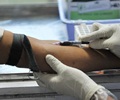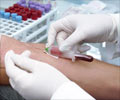
Previous data had suggested that HIV incidence among IDUs has declined. This trend is often attributed in part to harm reduction measures, including needle exchange programs and substance abuse treatment. However, these measures have not been as successful in lowering the rates of HCV incidence and prevalence. For example, HCV infection is nearly 10 times more transmissible by sharing needles than is HIV infection. Sharing a needle even once can be enough to transmit HCV.
The investigators found that new cases of HIV infection declined dramatically across four different time periods during the past 20 years, from 5.5 per 100 person-years (PY) in 1988-'89, to two per 100 PY in 1994-'95, and to zero cases in 1998 and 2005-'08. While researchers also observed reductions in new cases of HCV infection, these were not nearly as substantial: from 22 per 100 PY in 1988-'89, to 17.2 per 100 PY in 1994-'95, to 17.9 in 1998, and to 7.8 per 100 PY in 2005-'08. Overall, cases appeared to decline only among younger IDUs, who had started injecting drugs recently.
According to researchers, these data suggest that "current prevention efforts delay but do not prevent HCV at the population level and will need to be further intensified to reduce risk of HCV infection to the level of HIV." Efforts on both the prevention and the treatment fronts to reduce the reservoir of HCV-infected IDUs will have to be expanded, the investigators concluded.
In an accompanying editorial, Jason Grebeley, PhD, and Gregory J. Dore, MB BS, MPH, PhD, of the University of New South Wales in Australia, agreed that higher prevalence of HCV infection and greater transmission risk following an injection with a contaminated syringe as compared to HIV have hampered harm reduction measures. They also noted that current implementation of harm reduction measures in most settings is inadequate. Rates of equipment sharing remain high, and access to opioid substitution therapy and other drug treatment programs is limited.
The editorial authors also pointed out the impact that an HCV vaccine could have on new cases of HCV infection. Though a highly efficacious vaccine has not yet been discovered, efforts to do so are crucial. They suggested that even though the window for preventing HCV may be small, improvements in HCV prevention are feasible.
Advertisement














